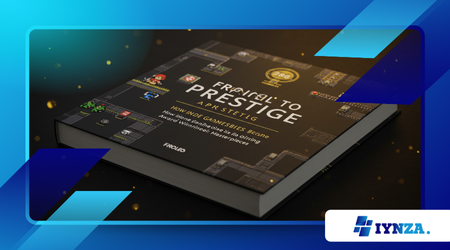From Pixel to Prestige: How Indie Games Became Award-Winning Masterpieces

Indie games have transformed from humble pixelated projects into critically acclaimed masterpieces, reshaping the gaming landscape.
Anúncios
This evolution from “Pixel to Prestige” highlights the journey of independent developers who, with limited resources, have created games that rival big-budget titles in creativity and impact.
The Rise of Indie Games
The rise of indie games didn’t happen overnight. It began with the introduction of game engines like Unity and GameMaker, which opened the doors for small teams and solo developers to build games without needing millions in funding.
The early success of titles like Braid, World of Goo, and Super Meat Boy showcased the potential of this movement. These titles pushed past the gatekeepers, bypassed traditional publishers, and proved that direct connection with players was not only possible but powerful.
By the 2010s, platforms like Steam, Xbox Live Arcade, and eventually the Nintendo eShop embraced indie titles. What once was a niche category began drawing mass attention.
Accessibility, affordability, and passion-driven design made indie games the go-to choice for players craving originality and heart. This wasn’t just a trend—it was a foundational shift.
Artistic Innovation and Storytelling
Indie developers have an edge when it comes to risk-taking. Without the pressure of appeasing shareholders, they can explore unconventional art styles and narratives. Journey, for instance, told a deeply emotional story with no dialogue, relying solely on visuals and music.
Undertale flipped traditional RPG mechanics and moral choices on their head, making every decision feel intensely personal.
These titles resonated not because of flashy graphics, but because they offered experiences that couldn’t be found elsewhere.
The freedom to innovate allowed indie games to break molds, challenge player expectations, and redefine what storytelling in games could be. This dedication to originality is what separates indie masterpieces from formulaic blockbusters.
Read also: Hidden Gems: Underrated Indie Games That Deserve Your Attentions
Critical Acclaim and Industry Recognition
Today, it’s common to see indie titles featured alongside AAA releases in award shows and year-end lists. The Game Awards, BAFTA Game Awards, and Independent Games Festival have consistently recognized the impact of these smaller projects. When Hades won Best Action Game and was nominated for Game of the Year, it wasn’t seen as a fluke—it was a culmination of a decade-long shift.
This recognition didn’t just validate the creative talent behind indie games—it changed the perception of what a successful game looks like. It opened doors for more funding opportunities, better visibility in storefronts, and even cross-media adaptations like shows and comics.
The prestige once reserved for big studios now includes teams of five—or even solo creators—whose ideas resonate globally.
Community Engagement and Cultural Impact
One of the most powerful aspects of indie games is how closely they connect with their communities.
Developers often share early builds, invite feedback, and engage with fans on social media or Discord. This creates a collaborative loop where the game grows alongside its players, forging loyalty and authenticity.
Indie games have also sparked cultural conversations. Papers, Please tackled immigration and moral complexity. Celeste addressed mental health and resilience.
These themes reach beyond the screen, prompting reflection, discussion, and connection among players. What began as small-scale projects now serve as cultural artifacts—mirrors of societal challenges and human emotion.
The Power of Constraints in Creativity
One often overlooked factor behind the rise of indie game innovation is the power of constraint. With limited budgets, smaller teams, and shorter development cycles, indie creators are forced to prioritize what truly matters.
This leads to tighter gameplay mechanics, more intimate narratives, and experimental design choices that may never see daylight in risk-averse AAA environments.
Constraint doesn’t weaken creativity—it sharpens it. It encourages focus, ingenuity, and a deeper connection between the vision of the developer and the execution of the game.
This minimalist ethos has given birth to titles that are laser-focused in experience yet boundless in emotional impact.
Player-Centric Design and Iteration
Indie studios often develop with their audiences, not just for them. Unlike major studios that rely heavily on market research and trend analysis, indie teams can pivot mid-development, respond directly to player input, and polish based on real-time community feedback.
This agile approach results in products that feel more aligned with player expectations—and often surpass them.
Successful indie games like Slay the Spire and Dead Cells thrived in Early Access before full release, using community input as a foundation.
The result isn’t just better balance and fewer bugs, but a product born from genuine dialogue between developer and player. It’s a co-creation process that builds loyalty and trust.
A New Definition of Success in Gaming
In the indie space, success isn’t just measured in sales—it’s measured in impact. A game that sells 100,000 copies can be life-changing for a solo developer.
A title that resonates deeply with a niche audience can define a genre. Prestige comes not just from profits, but from passion.
This new definition of success is reshaping the industry’s values. It encourages diversity in voices, themes, and playstyles.
It proves that heartfelt games made on tight budgets can stand shoulder to shoulder with the giants—not because they mimic them, but because they dare to be different.
Why This Matters to the Future of Gaming
The success of indie games isn’t just a feel-good story—it’s a blueprint. As development tools become more sophisticated and funding platforms like Kickstarter and Patreon continue to support creators, the indie space will only grow stronger.
This evolution means more diverse stories, more experimental gameplay, and more players finding experiences that truly resonate.
With the ongoing rise of cloud gaming and digital distribution, discoverability is improving. Platforms are starting to highlight quality over budget.
Gamers are learning that innovation often comes from those with fewer constraints—and more freedom to create what matters.
FAQ: From Pixel to Prestige
1. What defines an indie game today?
An indie game is typically developed by a small team without the backing of a large publisher. What defines it most is creative freedom and personal vision.
2. Why are so many indie games winning awards now?
Because they push boundaries. Indie games often explore unique mechanics and stories that resonate deeply with players and critics.
3. Can indie games match the quality of AAA titles?
Absolutely. While they may not have the same production budgets, many indie games excel in innovation, polish, and emotional depth.
4. How can I support indie developers?
Buy their games directly, share them online, leave reviews, and engage with them on social media. Every bit of support helps.
5. What are some recent award-winning indie games?
Hades, Celeste, Return of the Obra Dinn, and Outer Wilds are standout examples from the past few years.
